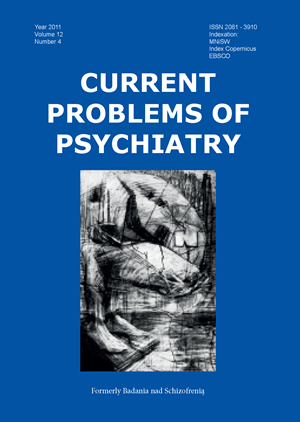Zespół majaczenia w przebiegu alkoholowego zespołu abstynencyjnego powikłany rabdomiolizą
Słowa kluczowe:
alkoholowy zespół abstynencyjny, delirium, mioglobinuria, rabdomioliza, zespół zmiażdżeniaAbstrakt
Rabdomioliza jest spowodowana przeniknięciem składników komórek mięśniowych, w tym mioglobiny, kinazy kreatynowej, amino-transferazy alaninowej i aminotransferazy asparaginowej to krwiobiegu. Niektóre z tych białek sarkoplazmatycznych takie jak mioglobina mają bezpośrednio toksyczny wpływ na komórki nerkowe, a także mogą doprowadzać do zablokowania nerkowych naczyń krwionośnych i zaburzyć proces ukrwienia nerek. Oba te mechanizmy są szkodliwe dla nerek i mogą prowadzić do ich niewydolności. Najczęściej opisywanymi przyczynami rabdomiolizy są czynniki fizyczne uszkadzające tkankę mięśniową: uraz zmiażdżeniowy, wyczerpujący wysiłek fizyczny, rozległe oparzenia, porażenie prądem elektrycznym, stan astmatyczny, tężec, gromadne napady padaczkowe lub stan padaczkowy, ostre psychozy, alkoholowy zespół abstynencyjny. U niektórych osób występuje również predyspozycja genetyczna i zwiększone ryzyko do wystąpienia rabdomiolizy. W pracy przedstawiono przypadek 35-letniego mężczyzny z rabdomiolizą, spowodowaną przez pobudzenie psychoruchowe w przebiegu majaczenia w alkoholowym zespole abstynencyjnym. Pierwszym obserwowanym objawem było ciemnobrązowe zabarwienie moczu jako objaw mioglobinurii, z towarzyszącym wzrostem poziomu mioglobiny i kinazy kreatynowej we krwi. Stężenie mioglobiny w surowicy wynosiło 3300 ng/ml a kinazy kreatynowej 182000,00 U/L. Poprawa stanu klinicznego pacjenta była obserwowana po szybkim wprowadzeniu płynoterapii, która zapobiegła rozwojowi ostrej niewydolności nerek.
Bibliografia
1. Habrat B., Zaburzenia psychiczne spowodowane przyjmowaniem środków psychoaktywnych. W: Bilikiewicz A., red. Psychiatria podręcznik. Wyd. III. Warszawa. PZWL. 2007; 11: 239-269.
2. Wasilewski D., Matsumoto H., Kur E., Dziklińska A., Woźny E., Stencka K., Skalski M., Chaba P., Szelenberger W.. Leczenie majaczenia alkoholowego przy pomocy szybkiego nasycania diazepamem. Psychiatr Pol 1995; 29: 675-686.
3. Erwin W.E., Williams D.A., Speir W.A.: Delirium tremens. So Med. J 1998, 91: 425-432.
4. Mast R.C. van der: Pathophysiology of delirium. J Geriatr Psychiatry Neurol, 1998, 11: 138-145.
5. Wojnar M., Bizoń Z., Wasilewski D., The role of somatic and physical injury in the development of alcohol withdrawal delirium. Alcohol. Clin Exp Res 1999; 23: 209–213.
6. Karch S.B., Stephens B.G., Drug abusers who die during arrest or in custody. J Royal Soc Med. 1999; 92: 110–113.
7. Park K.S., Korn C.S., Henderson S.O., Agitated delirium and sudden death: Two case reports. Prehosp Emer Care 2001; 214–216.
8. Vanholder R., Sever M.S., Erek E., Lameire N.: Rhabdomyolysis. J Am Soc Nephrol 2000; 11: 1553-1561.
9. Bywaters E.G., Beall D., Crush injuries with impairment of renal function. BMJ 1941; 1: 427-432.
10. Bywaters E.G. (1990). 50 years on: the crush syndrome. BMJ 1990; 301: 1412–1415.
11. Gabon P.A., Kaehny W.D., Kelleher S.P.,: The spectrum of rhabdomyolysis. Medicine 1982; 61: 141-152.
12. Vanholder R., Sever M.S., Erek E., Lameire N:. Acute renal failure to the crush syndrome: towards an era of seismonephrology. Nephrol Dial Transplant 2000; 15: 1517-1521.
13. Dembińska-Kieć A., Naskalski J.W., Podstawy diagnostyki laboratoryjnej z elementami biochemii klinicznej, wyd II. 2005; 17: 543-546.
14. Huerta-Alardín A.L., Varon J., Marik P.E., Bench-to-bedside review: rhabdomyolysis – an overview for clinicians. Critical Care 2005; 9: 158–169.
15. Pelonero A.L., Levenson J.L., Pandurangi A.K., Neuroleptic malignant syndrome: A review. Psychiatr Serv 1998; 49: 1163–1172.
16. Samuel E., Williams R.B., Ferrell R.B., Excited delirium: Consideration of selected medical and psychiatric issues. Neuropsychiatr Dis Treat 2009; 5: 61-66.


